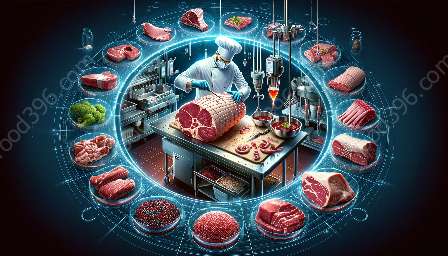Meat processing is a critical step in ensuring the safety and quality of meat products for consumption. It involves various stages that are vulnerable to pathogen contamination, making comprehensive control measures essential. This article discusses pathogen control measures in meat processing, considering aspects related to meat safety, hygiene, and meat science.
Understanding Pathogens in Meat Processing
Pathogens are microorganisms that can cause illness when ingested. In meat processing, common pathogens include bacteria such as Salmonella, E. coli, Listeria, and Campylobacter. These microorganisms pose a significant threat to public health if not adequately controlled during meat processing.
Meat Safety Measures
Ensuring the safety of meat products requires a multi-faceted approach that encompasses various control measures. This includes:
- Temperature Control: Proper temperature control at all stages of meat processing is essential in preventing the growth and survival of pathogens. This involves maintaining cold storage temperatures and applying heat treatment during cooking processes to eliminate pathogens.
- Cross-Contamination Prevention: Implementing strict protocols to prevent cross-contamination between raw and cooked meat, as well as between different types of meat products, is crucial in mitigating the risk of pathogen transfer.
- Sanitation and Hygiene: Maintaining high standards of cleanliness in meat processing facilities, equipment, and personnel is fundamental in reducing the potential for pathogen contamination. This includes regular cleaning and disinfection practices.
- Testing and Monitoring: Implementing robust testing and monitoring procedures to detect and identify potential pathogens in meat products and processing environments. This may involve microbial testing of samples and monitoring of processing conditions to ensure compliance with safety standards.
Hygiene Practices in Meat Processing
Adhering to strict hygiene practices is crucial in preventing pathogen contamination in meat processing. This involves:
- Personal Hygiene: Implementing stringent hygiene protocols for personnel, including handwashing, wearing appropriate protective clothing, and maintaining good personal hygiene practices to prevent the spread of pathogens.
- Facility Hygiene: Ensuring that processing facilities are designed and maintained to uphold high standards of cleanliness, including adequate drainage, waste management, and separation of raw and cooked meat processing areas.
- Equipment Hygiene: Regular cleaning and sanitization of processing equipment and utensils to minimize the risk of pathogen transfer during meat processing operations.
- High-Pressure Processing (HPP): HPP is a non-thermal technology that uses high pressure to inactivate pathogens in meat products while preserving the product's sensory and nutritional qualities. It has emerged as a promising method for enhancing meat safety.
- Antimicrobial Interventions: The use of natural antimicrobial compounds or innovative interventions, such as bacteriophages and bio-based antimicrobials, to control pathogens in meat products, offering effective alternatives to traditional chemical interventions.
- Advanced Packaging Technologies: Utilization of advanced packaging materials and technologies, such as modified atmosphere packaging (MAP) and active packaging, to extend the shelf life of meat products and inhibit pathogen growth through controlled atmospheric conditions and antimicrobial agents.
Meat Science Innovations for Pathogen Control
Advancements in meat science have led to the development of innovative technologies and interventions for pathogen control in meat processing. These include:
Ensuring Compliance with Regulations and Standards
Compliance with stringent regulations and standards is paramount in meat processing to ensure the implementation of effective pathogen control measures. This includes adhering to guidelines set by regulatory bodies such as the USDA (United States Department of Agriculture) and the FDA (Food and Drug Administration), as well as industry-specific standards.
Training and Education
Providing comprehensive training and education for personnel involved in meat processing is essential in fostering a culture of awareness and understanding of pathogen control measures. This includes training on proper handling, hygiene practices, and understanding the science behind pathogen control.
Conclusion
Pathogen control measures in meat processing are integral to ensuring the safety, quality, and integrity of meat products. By implementing a multifaceted approach that encompasses meat safety, hygiene practices, and advancements in meat science, the industry can mitigate the risk of pathogen contamination and uphold high standards of food safety for consumers.

